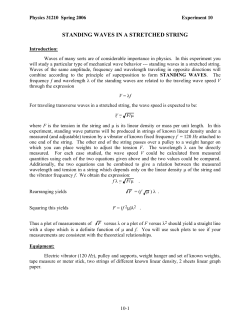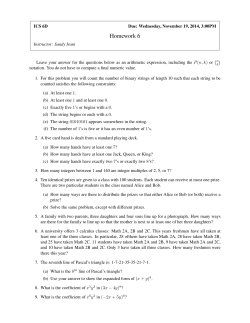
Physics 41 Chapter 21 Lecture Problems
Physics 41 Chapter 21 Lecture Problems Interference: Phase Difference: ∆= φ ∆φ = ω∆t = 2π f ∆t = 2π v λ ∆t = 2π 2π λ ∆r + ∆φ0 Path Difference: ∆= r (v∆t ) = 2π λ ∆φ 2π ∆r λ λ Constructive Interference: ∆= φ 2nπ , = r nλ , ∆= n 0,1, 2,3... λ Destructive Interference: ∆r= (2n + 1) , ∆φ= (2n + 1)π , n= 0,1, 2,3... 2 Is the interference constructive or destructive at P for in phase waves? Waves out of phase by 180 degrees? Are these sources in phase or out of phase? Is it constructive or destructive interference at P,Q, R? Count the wavelengths! r1 r2 ∆r ∆φ C/D r1 r2 ∆r ∆φ C/D P Q R P Q R P 1. Two sinusoidal waves are described by the wave functions y1 = (5.00 m) sin[π(4.00x – 1 200t)] and y2 = (5.00 m) sin[π(4.00x – 1 200t – 0.250)] where x, y1, and y2 are in meters and t is in seconds. (a) What is the amplitude of the resultant wave? (b) What is the frequency of the resultant wave? 2. Two loudspeakers are placed on a wall 2.00 m apart. A listener stands 3.00 m from the wall directly in front of one of the speakers. A single oscillator is driving the speakers at a frequency of 300 Hz. (a) What is the phase difference between the two waves when they reach the observer? (b) What If? What is the frequency closest to 300 Hz to which the oscillator may be adjusted such that the observer hears minimal sound? 3. An observer stands 3 m from speaker A and 4 m from speaker B. Both speakers, oscillating in phase, produce 170 Hz waves. The speed of sound in air is 340 m/s. What is the phase difference (in radians) between the waves from A and B at the observer’s location, point P? a. b. c. d. e. 0 π 2 π 2π 4π 4. Two waves in a long string are given by x y1 = (0.015 0 m )cos − 40t 2 and x y2 = (0.015 0 m )cos + 40t 2 where y1, y2, and x are in meters and t is in seconds. (a) Determine the positions of the nodes of the resulting standing wave. (b) What is the maximum transverse position of an element of the string at the position x = 0.400 m? 5. Two harmonic waves traveling in opposite directions interfere to produce a standing wave described by y = 2 sin (πx) cos (3πt) where x is in m and t is in s. What is the distance (in m) between the first two antinodes? a. b. c. d. e. 8 2 4 1 0.5 6. A string with a mass of 8.00 g and a length of 5.00 m has one end attached to a wall; the other end is draped over a pulley and attached to a hanging object with a mass of 4.00 kg. If the string is plucked, what is the fundamental frequency of vibration? 7. A string is stretched and fixed at both ends, 200 cm apart. If the density of the string is 0.015 g/cm, and its tension is 600 N, what is the fundamental frequency? a. b. c. d. e. 316 Hz 632 Hz 158 Hz 215 Hz 79 Hz 8. A string of length L, mass per unit length µ , and tension T is vibrating at its fundamental frequency. What effect will the following have on the fundamental frequency? (a) The length of the string is doubled, with all other factors held constant. (b) The mass per unit length is doubled, with all other factors held constant. (c) The tension is doubled, with all other factors held constant. 9. A glass tube (open at both ends) of length L is positioned near an audio speaker of frequency f = 680 Hz. For what values of L will the tube resonate with the speaker? 10 A clarinet behaves like a tube closed at one end. If its length is 1.0 m, and the velocity of sound is 344 m/s, what is its fundamental frequency (in Hz)? a. b. c. d. e. 264 140 86 440 172 11. In certain ranges of a piano keyboard, more than one string is tuned to the same note to provide extra loudness. For example, the note at 110 Hz has two strings at this frequency. If one string slips from its normal tension of 600 N to 540 N, what beat frequency is heard when the hammer strikes the two strings simultaneously?
© Copyright 2025





















